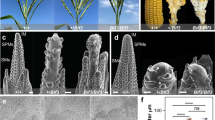Abstract
The technique of ‘fate-mapping’ or ‘mosaic mapping’ takes advantage of genetically marked progenitor cells that confer a phenotypic difference in order to determine the cells' contribution to the final organism. Pioneered by the gynandromorph studies of Sturtevant1, this technique has been used extensively to understand Drosophila development2. For certain plant species, naturally occurring chloroplast mosaics have been used to follow cell lineages3. In other plant species, mosaics can be generated by using X-ray-induced somatic mutations4,5. Here we have used X rays to create genetic sectors in maize that are lacking a mutation which alters leaf development—Knotted or Kn. From the sectors observed, we determined that the genotype of the mesophyll (internal cell layers) and not the genotype of the epidermis (outer layer) was critical for Kn expression, and that the mesophyll induced the epidermis to divide.
Similar content being viewed by others
References
Sturtevant, A.H. Z. wiss. Zool. 135, 323–356 (1929).
Hotta, Y. & Benzer, S. Nature 240, 527–536 (1972).
Stewart, R. N. & Dermen, H. Am. J. Bot. 66, 47–58 (1979).
Steffensen, D. M. Am. J. Bot. 55, 354–369 (1968).
Coe, E. H. & Neuffer, M. G. in The Clonal Basis of Development (eds Subtelny, S. & Susses, I.) (Academic, New York, 1978).
Freeling, M. & Hake, S. Genetics 111, 617–634 (1985).
Bryan, A. A. & Sass, J. E. J. Hered. 32, 343–346 (1941).
Poething, S. in Contemporary Problems in Plant Anatomy (eds White, R. A. & Dickinson, W. C.) (Academic, New York, 1984).
Steffensen, D. M. Am. J. Bot. 55, 354–369 (1968).
Green, P. B. & Lang, J. M. Planta 151, 413–426 (1981).
Selker, J. M. L. & Green, P. B. Planta 160, 289–297 (1984).
Lyndon, R. F. Ann. Bot. 49, 281–290 (1982).
Green, P. B. A. Rev. Pl. Physiol. 31, 51–82 (1980).
Ledin, B. Am. J. Bot. 41, 11–17 (1954).
Abbe, E. C., Phinney, B. O. & Baer, D. F. Am. J. Bot. 38, 744–751 (1951).
Gelinas, D., Postlethwait, S. N. & Nelson, O. E. Am. J. Bot. 56, 671–678 (1969).
Sharman, B. C. Ann. Bot. 6, 245–282 (1942).
Hake, S., Bird, R. McK., Neuffer, M. G. & Freeling, M. in Plant Genetics (ed. Freeling, M.) (Liss, New York, 1985).
Stewart, R. N., Meyer, F. G. & Dermen, H. Am. J. Bot. 59, 515–524 (1972).
Author information
Authors and Affiliations
Rights and permissions
About this article
Cite this article
Hake, S., Freeling, M. Analysis of genetic mosaics shows that the extra epidermal cell divisions in Knotted mutant maize plants are induced by adjacent mesophyll cells. Nature 320, 621–623 (1986). https://doi.org/10.1038/320621a0
Received:
Accepted:
Published:
Issue Date:
DOI: https://doi.org/10.1038/320621a0
- Springer Nature Limited
This article is cited by
-
Genetic mapping of QTL for the sizes of eight consecutive leaves below the tassel in maize (Zea mays L.)
Theoretical and Applied Genetics (2016)
-
Identification of phloem-mobile mRNA
Journal of Plant Research (2015)
-
An Hieracium mutant, loss of apomeiosis 1 (loa1) is defective in the initiation of apomixis
Sexual Plant Reproduction (2007)
-
Leaf Initiation: The Integration of Growth and Cell Division
Plant Molecular Biology (2006)
-
The HY2 gene as an efficient marker for transposon excision in Arabidopsis
Molecular Genetics and Genomics (2003)





